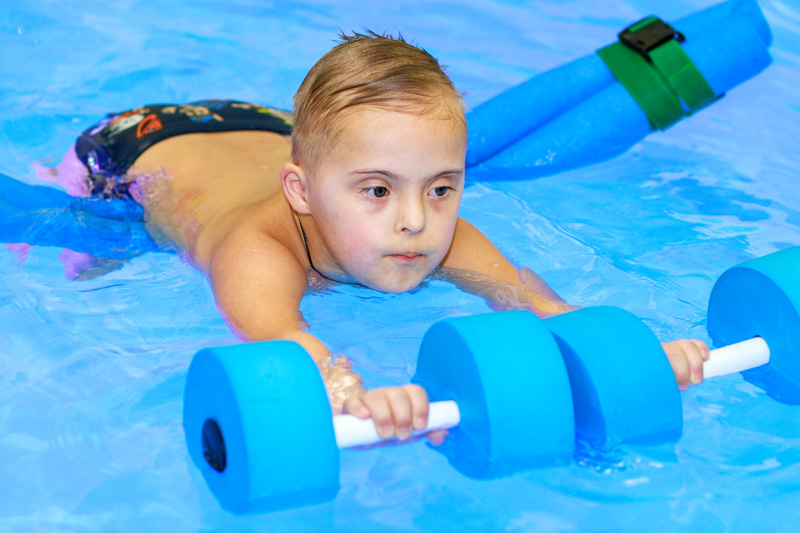The pool is a great tool to use to cool down and engage individuals with autism spectrum disorder (ASD) over the summer. Not only can water exploration in the pool provide socialization opportunities in a natural environment, but water can meet essential sensory needs as it provides deep pressure to calm the body, resistance to build strength and provide sensory input to the body, and gross motor movement to help regulate the body (Torres-Ronda & Schelling i del Alcázar, 2014). Additionally, individuals with ASD enjoy swimming more than individuals without ASD (Eversole et al., 2016), supporting the integration and exploration of the pool to provide leisure activity engagement. There are many things that can be done to prepare for the pool to create a safe experience and meet the sensory needs of individuals with ASD.

Tapping into the Sensory System
In order to meet an individual’s sensory needs, it is important to consider what those sensory needs are. Below are some examples of how to create the best sensory pool experience.
Movement Seeker/Adventurous Explorer: If an individual with ASD enjoys crashing into objects, jumping off of surfaces, spinning, and/or desires frequent movement, consider providing opportunities to jump into the pool, climb/pull out of the pool, or swim laps for the trained swimmer. The resistance of the water (Torres-Ronda & Schelling i del Alcázar, 2014), along with the rote movement of swimming laps, can be calming and provide the needed movement that is often desired on land. Additionally, while swimming laps, the corpus callosum, or middle of the brain, sends messages between both hemispheres of the brain (Goldstein et al., 2023). This communication between both sides of the brain encourages tracking across the midline of the body or integrating both the left and right sides of the body (Goldstein et al., 2023), a skill that helps to prepare an individual with ASD to read, engage in math, and have more awareness of their body.
Movement Avoider/Cautious Explorer: If an individual with ASD is cautious with movement, avoids various textures, or selectively engages in sensory activities, provide opportunities to interact with water outside of the pool first. Throw or set objects into the pool to see how they float; scoop water out of the pool into other containers to observe the movement of the water, which can be visually calming and/or regulating; throw toys into the pool and encourage retrieval of the objects from the side of the pool; and/or even dip a sponge into the water and encourage washing hands, arms and/or legs with the sponge. Never force water participation, but rather encourage curiosity and exploration in a way that promotes comfort while still interacting and enjoying water. Once an individual with ASD is ready to enter the pool, allow them to hold onto you or the side of the pool so they feel anchored to an object. Once they feel comfortable moving away from the edge of the pool, engage them in rhythmic swaying or rocking, as this can be calming and regulating for the sensory system.
Safety
While swimming provides many social, leisure, and sensory opportunities, it is important to prioritize safety, as drowning is the number one cause of death for children with ASD (Drowning Prevention & Facts, n.d.). First, always make sure that you are watching and at a safe distance so that you can assist as needed – think an arm’s length for the novice swimmer and within two arm’s lengths for those more experienced. Additionally, make sure to swim at pools and beaches with certified lifeguards for additional safeguards. If a personal flotation device is needed to create a safer environment for the individual with ASD, make sure that the personal flotation device is Coast Guard-approved. If an individual with ASD has choked on water while swimming and continues to cough hours afterward or spikes a fever, consult a medical professional.
Before Entering the Pool
To prepare for the pool, set expectations and rules for everyone who will be entering or interacting with the water. These rules can include asking for permission from a caregiver before entering the pool or always holding hands on the pool deck. If routine change is challenging, consider providing social stories or watching a video to help with understanding the steps and expectations of the pool. Providing verbal cues or narrating what is happening can also be helpful. If needed, contact the pool manager and provide the lifeguards and/or staff with information about the individual with ASD so they can take extra precautions. Additionally, providing the individual with ASD pictures or a tour of the pool and surrounding area can be very helpful.
Maggie Achenbrener OTD-PP, OTR/M, is Assistant Professor at Concordia University Wisconsin. Alysha Skuthan, PhD, OTR/L, ASDCS, is Assistant Professor at Shenandoah University. For any additional questions, feel free to contact Maggie Achenbrener, OTD, OTR/M, an aquatic occupational therapist, at maschenbrener1@gmail.com.
References
Drowning Prevention & Facts. (n.d.). American Red Cross. https://www.redcross.org/get-help/how-to-prepare-for-emergencies/types-of-emergencies/water-safety/drowning-prevention-and-facts.html
Eversole, M., Collins, D. M., Karmarkar, A., Colton, L., Quinn, J. P., Karsbaek, R., Johnson, J. R., Callier, N. P., & Hilton, C. L. (2016). Leisure activity enjoyment of children with autism spectrum disorders. Journal of Autism and Developmental Disorders, 46(1), 10–20. https://doi.org/10.1007/s10803-015-2529-z
Goldstein, A., Covington, B. P., Mahabadi, N., & Mesfin, F. B. (2023, April 3). Neuroanatomy, corpus callosum. StatPearls – NCBI Bookshelf. https://www.ncbi.nlm.nih.gov/books/NBK448209/
Torres-Ronda, L., & Schelling i del Alcázar, X. (2014). The properties of water and their applications for training. Journal of Human Kinetics, 44(1), 237–248. https://pubmed.ncbi.nlm.nih.gov/25713684/







